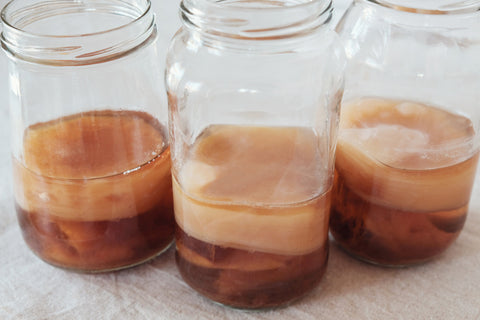The Kombucha Kraze: What You Need to Know
October 21, 2019

Last month we discussed how probiotics are popping up everywhere - in coffee, cereal, dog food, and cleaning products. We explained spore-forming bacteria and why they are convenient to the manufacturer but may have no benefit to the consumer -- that’s you! And, we mentioned how a large percentage of Kombucha drink manufacturers are now adding these questionable bacterial species to their drinks. If you haven’t read that blog, and you fancy your Kombucha, you may want to start there. Here, we are going to take a closer look at Kombucha, what is it made out of, its potential for both biological and chemical contaminants and some of the reasons why we question its consumption.
What is Kombucha Anyway?
Kombucha is a beverage produced by fermenting sweet tea with a culture of yeast and bacteria. The culture is often referred to as a SCOBY - or a Symbiotic Culture Of Bacteria and Yeast and frequently referred to as a “mother” or “mushroom” (because of the shape it takes on).

Sometimes, when discussing our concerns with kombucha, we think all you really need to do is reread that definition and let it process for a moment. Sweet tea, yeast, and bacteria -- let’s look at these more closely:
Sweet tea
-- black or green tea leaves combined with lots of sugar. While it’s true that the sugar is consumed during the fermentation process, it's also true that most companies selling kombucha add additional sugars after fermentation to make the drinks more palatable. A range of 7 to 10 grams of sugar per 8-ounce serving is common, however, keep in mind that the bottles sold are almost always 16-ounce bottles or larger, if you consume the whole bottle (and most people do), that’s 14 to 20 grams of sugar.
According to the American Heart Association, the maximum amount of added sugars you should consume in a day are 36 grams for men and 25 grams for women. You can see how one 16-ounce kombucha drink would put the average person almost at their recommended added sugar intake for the day. In terms of added sugar intake, drinking store-bought kombucha is problematic for your health.
|
DRINK
|
Sugar (grams)
|
Women (% of daily)
|
Men (% of daily)
|
|
Avrg. Kombucha 8 oz
|
7-10 g
|
28-40%
|
19-28%
|
|
Avrg. Kombucha 16oz
|
14-20 g
|
56-80%
|
39-56%
|
Yeast
-- you mean the same stuff we’ve been trying to get rid of with all those Candida cleanses everyone is talking about? What kind of yeast is in Kombucha?
The answer is -- we don’t really know and it can vary from batch to batch. This is especially true with homemade kombuchas. A German study analyzed 2 commercially available and 32 privately made homebrews of kombucha and found a few common yeasts including, Brettanomyces, Zygosaccharomyces, and Saccharomyces. Three of the specimens, “...showed definite contaminations. In one case, no yeasts could be isolated because of massive contamination with (bacteria). In the remaining two samples (from one household), Candida albicans was demonstrated.” Candida albicans is an opportunistic pathogenic yeast and well known as being the most prevalent cause of yeast/fungal infections in people, yikes! This won’t always be the case, but it is a cause for concern and we want people to be well aware that homebrewing should be taken seriously and all necessary steps for cleanliness and tests for proper fermentation pH should be strictly adhered to. Home fermentation is not for the novice and should be taken quite seriously as contamination can occur at many stages.
Another study we read observed even higher levels of Candida species in the kombucha they tested, reporting, “The yeast community of the biofilm did not show much variation over time and was dominated by Candida sp. (73.5-83%).” Again, Candida sp. are not all bad, ‘opportunistic pathogen’ means that usually it lives in sync with our body and is harmless, but a multitude of things can affect the balance of your internal ecosystem and lead to yeast overgrowth including alterations in your microbiota say if you are taking antibiotics or antifungal medications, changes in your immune system (ex. during stress, infections, immunosuppressive therapies), changes in your local gut environment (ex. shifts in gut pH, nutrient availability, diet changes) -- any of these can enable C. albicans to overgrow and cause infections.
Candida albicans infections range from mild mucus or skin infections like thrush, vaginal yeast infections, and diaper rash to much more serious infections. This particular yeast is known for its ability to create highly structured biofilms and is responsible for 15% of all hospital-acquired sepsis cases. Biofilms can form on urinary and central venous catheters, pacemakers, mechanical heart valves, joint prostheses, contact lenses, and even dentures. Once it has established on one of these surfaces it has the potential to get into the bloodstream causing bloodstream infections and even has sizable mortality rates (approaching 40% in some cases). And, while this is probably not an issue for most people -- why even risk it? There are safer things to drink and easier ways to get healthy, beneficial microbes into your body.
Bacteria
-- okay, so obviously as a probiotic company we’re all for the right probiotic bacteria -- but what bacteria exactly is in these drinks? Good bacteria? Again, much like the yeast, the bacterial composition can vary from batch to batch and there’s no real way for a homebrewer to know what their homebrew contains. Some of the common bacteria that tend to show up here include Gluconacetobacter, Lactobacillus and Acetobacter. The main concern here is after the tea has cooled and you are waiting for a pH of less than 4.2 to be achieved until that pH is reached contamination by bacterial pathogens can occur.
Biological & Chemical Contamination
We have already discussed yeast and Candida albicans above, but what other concerns are there with kombucha? If you consume contaminated kombucha you may experience dizziness, nausea, vomiting, headache, and jaundice. There has even been a case of cutaneous anthrax infection linked to kombucha consumption in India.
Another potential hazard is over-fermentation, the acid levels need to be monitored because over-fermentation can result in excessive acetic acid production. When this occurs, the pH drops and has the potential to leach out some chemical contaminants that may be present in the fermentation vessel and packaging materials. Cases of lead poisoning have been described when kombucha was brewed or stored in glazed earthenware.
Similarly, drinking too much kombucha has been tied to acidosis and kombucha consumption has proven to be harmful in a few documented instances, in one case the consumer was recently diagnosed with HIV, so again we urge caution to those with known immunocompromised states.
Other reports suggest exercising caution if consuming kombucha while taking medical drugs or hormone replacement therapy, it is thought that the medications may not absorb as well because they are sensitive to pH changes in the gut.
And still, other reports discuss concerns when consumed in large quantities, as was noted in two incidents occurring in Iowa in 1995. One individual, who died of cardiac arrest, was found to have perforations of the intestinal tract and severe acidosis. It was speculated that kombucha might have been the cause of death as she had consumed 4 oz per day of homemade kombucha for two months prior to the incident. Another individual, whose kombucha came from the same initial SCOBY, also suffered cardiac arrest and severe acidosis. She mentioned that she had increased her daily consumption from 4 oz to 12 oz and the fermentation time length from 7 days to 14 days and that she consequently could hardly manage to swallow the very acidic tea, but did so anyway. It was later determined that the individuals had pre-existing conditions that made them susceptible to acidosis but this still demonstrates our overall point that there are safer things to drink and easier ways to obtain get beneficial microbes into your body because, how do you know if you are an individual susceptible to such things?
It may seem that the issues described above are primarily concerns for those involved in homebrewing or who consume homebrews from family or friends. Stay tuned for part two of this blog where we will dive deeper into commercial kombucha brews and continue this discussion.
In the meantime, if you’re looking for a safe and easy way to support your internal ecosystem and positively affect your gut and overall health, why not try taking one of our powdered or encapsulated probiotics that have decades of proven safety records.
References:
https://www.heart.org/en/healthy-living/healthy-eating/eat-smart/sugar/added-sugars
http://www.bccdc.ca/resource-gallery/Documents/Educational%20Materials/EH/FPS/Food/kombucha1.pdf
https://www.ncbi.nlm.nih.gov/pubmed/8559192
https://www.cdc.gov/fungal/diseases/candidiasis/index.html
https://www.ncbi.nlm.nih.gov/pubmed/26796581
https://www.ncbi.nlm.nih.gov/pmc/articles/PMC4930275/
https://jamanetwork.com/journals/jama/article-abstract/1152389






Leave a comment